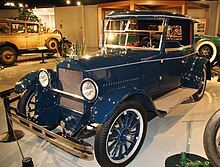Studebaker Light Six
The Studebaker Light Six was a passenger car made by the Studebaker Corporation in South Bend, Indiana from 1918 to 1924.
1918-1919
Light Six - also Model EH called - had mm a wheelbase of 3,023 and was powered by a six-cylinder in-line engine having 4,729 cc displacement (bore x stroke = 88.9 mm × 127 mm) consisting of that of the model Light Four - extended by 2 cylinders - corresponded and developed 50 bhp (37 kW) at 2,000 rpm. The engine power was transmitted to the rear wheels via a leather cone clutch and a three-speed gearbox with a gearshift lever in the middle of the car. The foot brake worked on the outer band brakes on the rear wheels.
In 1920 this medium-sized model series EH was renamed " Special Six " by Studebaker .
1920-1924
In 1920 a completely new EJ model appeared under the name Light Six. After the elimination of the Light Four, the cheapest model series from Studebaker had taken over the wheelbase of 2,845 mm from its four-cylinder predecessor and got a new, smaller six-cylinder in-line engine with 3,393 cm³ displacement (bore × stroke = 79.4 mm × 114.3 mm) and a maximum output of 40 bhp (29 kW). The engine power was passed on to the rear wheels via the three-speed gearbox via the new single-disc dry clutch.
The car was further built in this technical design in 1921 and 1922. In 1923, the new EM model featured all-steel bodies instead of the various structures in a mixed construction. In 1924 the equipment was improved: the front bumper and balloon tires were standard and the radiator frame was nickel-plated.
In August 1924, the successor for the 1925 model year appeared in the form of the Standard Six .
Web links
swell
- Beverly R. Kimes (Ed.), Henry A. Clark: The Standard Catalog of American Cars 1805-1942. Krause Publications, 1985, ISBN 0-87341-045-9 .
